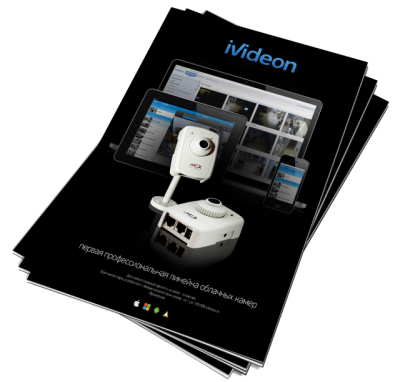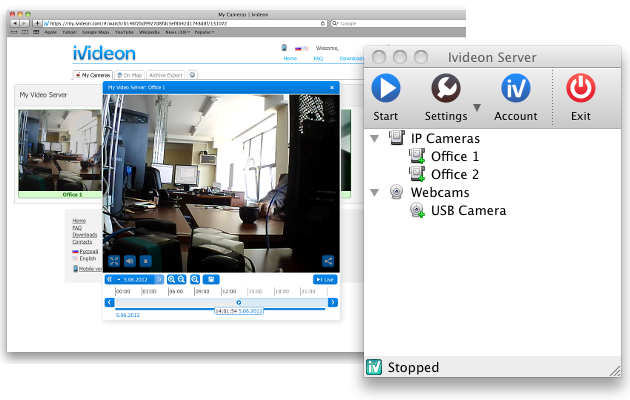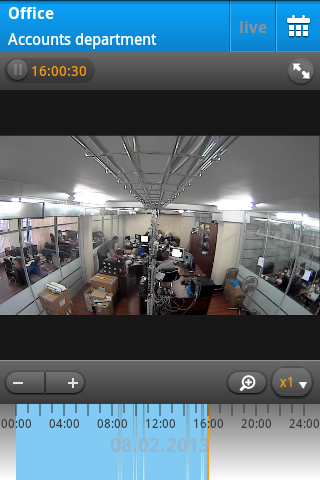Pizza, duck eggs, a bit of Linux and Android, or what's new in Ivideon

Most recently, our team returned from Sri Lanka. Since the end of December last year, we spent almost a month there. Between traveling around the country and relaxing on the ocean, we worked out new service features and general plans for the current year.
I'd like to tell you about our impressions of the trip and we will definitely do it next time (if it will be interesting to someone). And now our post will be devoted to what we managed to release during this time. The post will be useful primarily to existing users of our cloud-based video surveillance service, who very often complain about the lack of information about new features and capabilities. Nevertheless, I will try to clarify many terms and definitions so that new users can find useful information in this article. Go.
Ivideon tv

The project launched by us “in between”. I think that after completion he will deserve a separate post. And now I will talk about him briefly. Any Ivideon user can make one or more of their cameras public. Or simply open access to them and give everyone the opportunity to watch them. Embed in your website or simply, having received a link, share it on a social network. I am sure that some immediately imagined schoolgirls of dubious attractiveness, bored in front of the camera with a minimum of clothing. I will say right away that this is not so. Such cameras immediately fall into the ban and no longer appear.

Studios from radio stations, various events, including sports, the progress of construction of residential buildings, sometimes cafes, bars and restaurants, are broadcast through us. We even use some FMS. It often happens that people just show a view from their window. It seems to be nothing special. But in fact, someone lived 15 years ago on this street. And now he sees her changed, but still the same! Pleasant memories from the past .
And here is another camera. In real time you can see how your pizza is cooked , if you, of course, made an order at this pizzeria.
Not so long ago, our colleagues from the hi-testing project, which you probably already know, started broadcasting from an incubator with duck eggs!
In general, we collected all the public cameras broadcast using our service on our website and gave this project the code name Ivideon TV. He has not yet become the way we would like to see him; he still lacks a lot. Nevertheless, we decided to lay it out in the form in which it already exists now.
Ivideon server

For those who are not familiar with our service I will explain. Ivideon Server is an application that has all the basic features of a professional video surveillance server. It allows you to connect surveillance cameras to yourself and record on various detectors or events. Whether it’s movement in the frame, the appearance of an extraneous sound, or simply the beginning of a working day. On the other hand, Ivideon Server is a client of our cloud, allowing you to access cameras remotely using the Ivideon service wherever you are. From viewing all cameras in a web browser to accessing a video archive from a tablet running Android or IOS .
Over the past month, Ivideon Server has been substantially redesigned. As you may know, Ivideon Server is a cross-platform application. It is available for Windows, Linux, and Mac OS X. From an architectural point of view on all platforms, it represents the main service process (a service on Windows and a daemon on Linux), as well as a GUI shell for configuring it. Earlier versions of Ivideon Server for Windows and Mac OS X used a common configuration application written in QT, and the Linux version was configured using the Web interface.
For many, the web interface was inconvenient. It required additional installation of Apache and other third-party modules, making the installation process more complicated than installing Ivideon Server, for example, on Windows.
In this regard, we decided to release another version of Ivideon Server for Linux, which will be configured using the GUI, as well as the version for Windows or Mac OS X.

In addition to generalization, Ivideon Server also made changes to the add and camera settings. We hope that it has become more intuitive. After all, what we strive for is simplicity.
Ivideon client desktop

This application is for Windows, Mac OS X and Linux, created for those who prefer to use the application to access the cameras, rather than the web interface of your personal account . This time, Ivideon Client made many architectural improvements, which should significantly increase the reliability of its work on different platforms. Although not without the addition of new features.
Perhaps the most significant innovation is the ability to search in a video archive in a given area. Despite the fact that recording is carried out using a motion detector, as a rule, many hours of video appear in the archive in one day. Of course, it does not need to be viewed by everyone, but in the event of an abnormal situation, it was necessary to find the right moment in the archive and this was not easy.
Now we have added a new feature that allows you to search for those records where there was not just movement, but movement in a given area. For example, you know exactly where the phone was before it disappeared. Select this place and find all the records where the movement was in the area of the phone. The search volume will be significantly reduced.
This feature is currently in beta testing. Soon it will be transferred to new algorithms for tracking objects in the camera’s field of view, which will significantly increase the accuracy of its operation. And along with this, additional functions of video analysis will be added.
Ivideon Client Android

This is one of our most popular applications. Sometimes, its popularity and its growth relative to the application for iOS makes you wonder how fast the Android platform is spreading.
As well as the Desktop version, Ivideon Client for Android allows you to access your surveillance cameras wherever you are. For our part, we are constantly improving it, trying to make mobile access exactly convenient.
One of these improvements was, for example, the digital zoom function.
When you view a camera with a resolution of a couple of megapixels on a small screen, all the elements seem small. Now you have the opportunity to select the part of the frame of interest and zoom in.


It would seem that there is nothing complicated in this function. But in fact, in order to make it convenient, so that it could earn not only in Wi-Fi networks, but also in 3G, I had to try very hard. Especially considering our "cloud" architecture with a large number of users.
If the camera is more than 1 megapixel, we never send a full frame to a mobile device. Since in any case you won’t be able to see it in its entirety if your screen resolution is lower and the 3G network is not working in the best way so far. Therefore, the frame is recoded to the screen resolution on which the frame will be displayed taking into account the network bandwidth.
And even if your camera has a resolution of 1920x1080, you still get a 640x480 frame if the screen resolution is appropriate.
The appearance of the digital zoom function allows you to select the zone of interest in the frame, for example, 1920x1080, cut it and “fit” into the screen of the mobile device. And only such an implementation allows you to give a good result. Since forwarding and displaying a high-resolution frame can turn a video into a set of slides.
Summary
I tried to tell you very briefly about what we have done over the past month so that the article is not really boring. Therefore, far from everything entered into it. I hope that it will be useful and if so, we will continue to write about our developments and new features.
